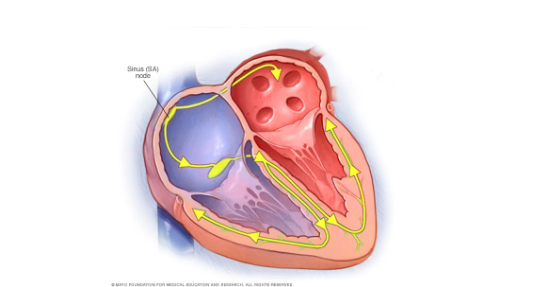By: Thalia Kaylyn Averil
Pacemaker is a small device that produces electrical signals to control the heart rhythm, ensuring that the heart beats regularly and preventing the occurrence of arrhythmias. Arrhythmias can cause the heart to beat too fast, too slow, or irregularly. Patients who need a pacemaker often experience symptoms such as dizziness, weakness, fatigue, fainting, or difficulty exercising. These symptoms often occur due to a heart rhythm that is too slow, problems with the sinoatrial node of the heart, or problems with electrical conduction between different parts of the heart. Pacemakers can also be used for patients with symptoms of heart blockage and heart failure. This device works by sending electrical signals to help the heart maintain a regular and proper rhythm. Apart from that, this tool can also regulate heart rate to increase the efficiency of blood circulation throughout the body.
What is the sinoatrial node? How is normal heart rhythm regulated?
Heartbeats are initiated by the heart itself. Some heart muscle cells can contract and relax by themselves without requiring signals from the nervous system. However, each heart muscle cell has its own natural rhythm for contracting, but these cells can contract simultaneously because it is regulated by a special group of cells located in the right side of the heart wall. These cells are called the sinoatrial (SA) node which acts like a natural pacemaker by regulating the speed and timing for all the heart muscle cells to contract together. The SA node produces electrical signals that are similar to nerve cells and can spread quickly because heart muscle cells are connected to each other through a network.

Figure 1. Sinoatrial node.
A pacemaker consists of a generator for pulses and leads/electrodes. A pulse generator is a small metal box containing a battery and other electrical components whose function is to produce an electric current that stimulates the heart muscle. The pulse generator is usually placed under the skin at the bottom of the chest, more specifically under the collarbone. Leads or electrodes are flexible cables consisting of one to three cables to be inserted into the heart chambers. This cable can transmit the electrical signals needed to correct the heart’s beat from the pulse generator.

Figure 2. Pacemaker.
- Single chamber
This type of pacemaker has one lead for delivering electrical signals, which is connected to the upper or lower chambers of the heart, usually to the lower right chamber of the heart. However, a single-chamber pacemaker can also be connected to the right upper chamber of the heart. The placement of this pacemaker is determined by the needs and symptoms experienced by the patient.
- Dual chamber
A dual chamber pacemaker has two leads for delivering electrical signals, which are connected to the upper heart chamber and the lower heart chamber, generally to the right side. Just like single chamber pacemakers, the placement of the pacemaker is determined by the needs and symptoms experienced by the patient.
- Biventricular
Biventricular pacemakers are also known as devices for cardiac resynchronization therapy (CRT). In general, this type of pacemaker is used for patients with heart failure and a heart rate that is slower than normal. Heart failure is often caused by the two lower chambers of the heart not being able to pump simultaneously. By using three cables connected to the right upper heart chamber, the right lower heart chamber, and left lower heart chamber, this device can enhance the performance of the heart muscle and regulate contractions in the lower chambers of the heart to contract simultaneously. This coordination helps the heart to pump blood more efficiently and can relieve symptoms of heart failure.
Before the pacemaker implantation procedure, you will be asked not to eat or drink anything for eight hours, and some medications will also need to be stopped. For the implantation of a pacemaker into the body, surgical intervention, which typically takes several hours to complete, is required. Once the procedure is complete, you can be sent home the same day or monitored for several hours, according to your health condition. Many patients can resume normal activities within a few days, but heavy lifting or heavy arm movements should be avoided for several weeks. Generally, your diet can also return to normal if there are no complications. You are advised to have regular health check-ups following the implantation of a pacemaker, consult this with your healthcare professional to determine the frequency of these check-ups.
Resources
- Urry LA, Cain ML, Minorsky PV, Wasseman SA, Reece JB. Campbell Biology. 12th ed. New York: Pearson Education; 2021.
- Mayo Clinic. Pacemaker [Internet]. Rochester: Mayo Clinic; date of publication unknown [cited 2024 Apr 9]. Available from: https://www.mayoclinic.org/tests-procedures/pacemaker/about/pac-20384689
- Stanford Medicine. Types of pacemakers [Internet]. Stanford: Stanford Medicine; date of publication unknown [cited 2024 Apr 9]. Available from: https://stanfordhealthcare.org/medical-treatments/p/pacemaker/types.html
